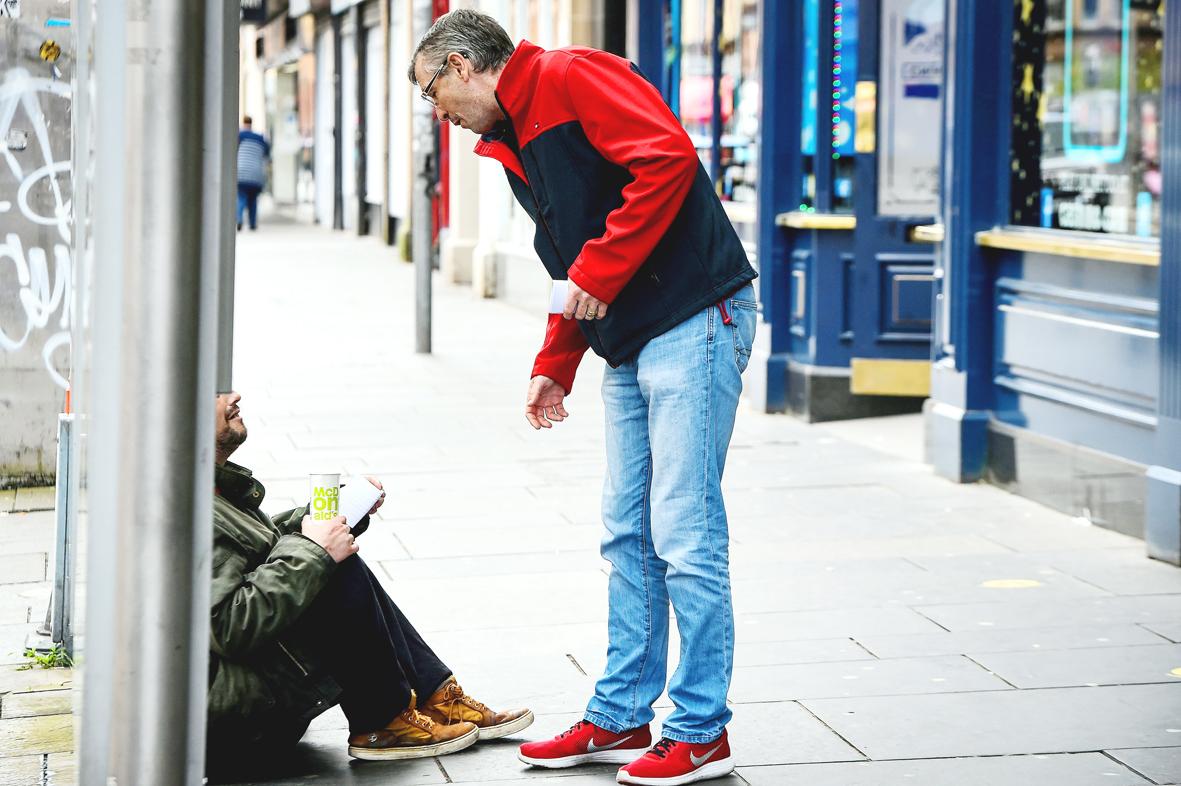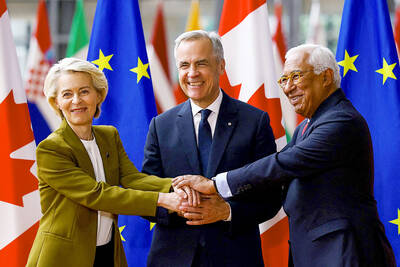In the shade of the buildings at the bottom end of a secluded street in central Glasgow, Peter Krykant gets out of his converted white minibus and glances up an adjacent alleyway.
Krykant, 43, knows these streets well. Before he gave up drugs 11 years ago, he was homeless and would inject cocaine and heroin in places just like these.
“We need to stop criminalizing people,” said Krykant, who started using drugs when he was 17. “We need to pull them out of the dark, rat-infested alleyways that they are currently using drugs in, pull them into a safe, supportive environment, and offer them the help and support that they need.”

Photo: AFP
Krykant’s experience as a drug user and the resistance he encountered from authorities to the idea of safe consumption rooms inspired him to buy his minibus in March.
He raised £2,400 (US$3,100) in a crowdfunding campaign and converted the van into a mobile sterile consumption facility.
It contains clean needles, injecting equipment and doses of Naloxone, a drug that can reverse the effects of an opioid overdose.
He took the vehicle out for the first time in the first week of this month.
He now plans to go out once or twice a week and eventually would like to see areas across Glasgow where drug users can inject in a safe, sterile environment.
Krykant, who is now a full-time drug policy campaigner, said that doing so would help save hundreds of lives.
However, while Scotland’s devolved government in Edinburgh backs the use of safe consumption areas, the country’s drug laws are governed by the British government.
The British Home Office has no plans to introduce drug consumption rooms or decriminalize drugs, which it says devastate lives and communities.
However, Krykant does not believe that what he is doing is illegal and hopes the Lord Advocate — Scotland’s most senior law officer — will challenge the constitutionality of the issue.
There is a large gray area in the law when it comes to establishing safe places for users to inject drugs, he said.
“Police Scotland have been great so far,” he said. “In terms of what they have to deal with, they are kind of between a rock and a hard place. How do you arrest or prosecute somebody for providing an internationally recognized way to reduce the harm caused by drugs, an evidence-based way?”
Scotland, which had 1,187 drug-related deaths in 2018, has one of the highest drug death rates in the world, according to the latest figures published by the Scottish government.
For those who inject drugs in filthy alleyways and parks in the often bleak Glasgow weather, the van is a welcome sight.
The first of the users arrive to make use of it shortly after 2pm. They include William Logan, a 48-year-old grandfather, his friend, and a young mother, both of whom ask to remain anonymous.
Logan collects a sterile parcel, which contains gloves, a mask, a sachet of sterilized water and a new syringe from Krykant, then sits at a table in the back of the van.
Logan unwraps his wrap of cocaine, dissolves it in a few drops of sterilized water in a metal spoon, pulls the mixture into a syringe and inserts the needle into a vein on his forearm.
“Bloody wonderful, just great,” he said as the drugs took effect.
He was clean of drugs for 18 years, but started using again while he was in prison. By the time he was released, he was injecting full-time again.
“I’ve seen some people mix drugs into their own urine,” he said. “Here you get sterile water and a syringe. It’s safe. It’s clean. There’s support. We don’t have to lie in filth.”
Krykant works his hands into a pair of medical gloves, drops the used syringes into a medical waste bin and methodically wipes down the surfaces where the users mixed the drugs.
The users usually inject three times a day, returning next at about 6pm.
By then though, Krykant will be at home with his family and they will once again be left to inject in a park, a derelict building or one of the alleys.

Drug lord Jose Adolfo Macias Villamar, alias “Fito,” was Ecuador’s most-wanted fugitive before his arrest on Wednesday, more than a year after he escaped prison from where he commanded the country’s leading criminal gang. The former taxi driver turned crime boss became the prime target of law enforcement early last year after escaping from a prison in the southwestern port of Guayaquil. Ecuadoran President Daniel Noboa’s government released “wanted” posters with images of his face and offered US$1 million for information leading to his capture. In a country plagued by crime, members of Fito’s gang, Los Choneros, have responded with violence, using car

Canada and the EU on Monday signed a defense and security pact as the transatlantic partners seek to better confront Russia, with worries over Washington’s reliability under US President Donald Trump. The deal was announced after a summit in Brussels between Canadian Prime Minister Mark Carney and European Commission President Ursula von der Leyen and European Council President Antonio Costa. “While NATO remains the cornerstone of our collective defense, this partnership will allow us to strengthen our preparedness ... to invest more and to invest smarter,” Costa told a news conference. “It opens new opportunities for companies on both sides of the

The team behind the long-awaited Vera Rubin Observatory in Chile yesterday published their first images, revealing breathtaking views of star-forming regions as well as distant galaxies. More than two decades in the making, the giant US-funded telescope sits perched at the summit of Cerro Pachon in central Chile, where dark skies and dry air provide ideal conditions for observing the cosmos. One of the debut images is a composite of 678 exposures taken over just seven hours, capturing the Trifid Nebula and the Lagoon Nebula — both several thousand light-years from Earth — glowing in vivid pinks against orange-red backdrops. The new image

OVERHAUL: The move would likely mark the end to Voice of America, which was founded in 1942 to counter Nazi propaganda and operated in nearly 50 languages The parent agency of Voice of America (VOA) on Friday said it had issued termination notices to more than 639 more staff, completing an 85 percent decrease in personnel since March and effectively spelling the end of a broadcasting network founded to counter Nazi propaganda. US Agency for Global Media (USAGM) senior advisor Kari Lake said the staff reduction meant 1,400 positions had been eliminated as part of US President Donald Trump’s agenda to cut staffing at the agency to a statutory minimum. “Reduction in Force Termination Notices were sent to 639 employees at USAGM and Voice of America, part of a